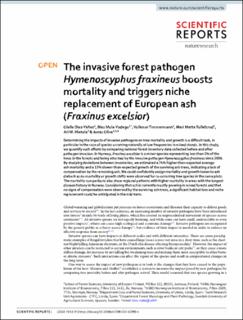| dc.contributor.author | Díaz-Yáñez, Olalla | |
| dc.contributor.author | Mola-Yudego, Blas | |
| dc.contributor.author | Timmermann, Volkmar | |
| dc.contributor.author | Tollefsrud, Mari Mette | |
| dc.contributor.author | Hietala, Ari Mikko | |
| dc.contributor.author | Oliva, Jonas | |
| dc.date.accessioned | 2020-12-03T13:14:11Z | |
| dc.date.available | 2020-12-03T13:14:11Z | |
| dc.date.created | 2020-04-30T22:17:45Z | |
| dc.date.issued | 2020-03-24 | |
| dc.identifier.citation | Scientific Reports. 2020, 10 . | en_US |
| dc.identifier.issn | 2045-2322 | |
| dc.identifier.uri | https://hdl.handle.net/11250/2711727 | |
| dc.description.abstract | Determining the impacts of invasive pathogens on tree mortality and growth is a difficult task, in particular in the case of species occurring naturally at low frequencies in mixed stands. In this study, we quantify such effects by comparing national forest inventory data collected before and after pathogen invasion. In Norway, Fraxinus excelsior is a minor species representing less than 1% of the trees in the forests and being attacked by the invasive pathogen Hymenoscyphus fraxineus since 2006. By studying deviations between inventories, we estimated a 74% higher-than-expected average ash mortality and a 13% slower-than-expected growth of the surviving ash trees, indicating a lack of compensation by the remaining ash. We could confidently assign mortality and growth losses to ash dieback as no mortality or growth shifts were observed for co-occurring tree species in the same plots. The mortality comparisons also show regional patterns with higher mortality in areas with the longest disease history in Norway. Considering that ash is currently mostly growing in mixed forests and that no signs of compensation were observed by the surviving ash trees, a significant habitat loss and niche replacement could be anticipated in the mid-term. | en_US |
| dc.language.iso | eng | en_US |
| dc.publisher | Springer Nature | en_US |
| dc.rights | Navngivelse 4.0 Internasjonal | * |
| dc.rights.uri | http://creativecommons.org/licenses/by/4.0/deed.no | * |
| dc.title | The invasive forest pathogen Hymenoscyphus fraxineus boosts mortality and triggers niche replacement of European ash (Fraxinus excelsior) | en_US |
| dc.type | Peer reviewed | en_US |
| dc.type | Journal article | en_US |
| dc.description.version | publishedVersion | en_US |
| dc.rights.holder | © The Author(s) 2020 | en_US |
| dc.source.pagenumber | 10 | en_US |
| dc.source.volume | 10 | en_US |
| dc.source.journal | Scientific Reports | en_US |
| dc.identifier.doi | 10.1038/s41598-020-61990-4 | |
| dc.identifier.cristin | 1808982 | |
| dc.relation.project | Norges forskningsråd: 235947 | en_US |
| dc.relation.project | EC/H2020/691149 | en_US |
| dc.source.articlenumber | 5310 | en_US |
| cristin.ispublished | true | |
| cristin.fulltext | original | |
| cristin.qualitycode | 1 | |

